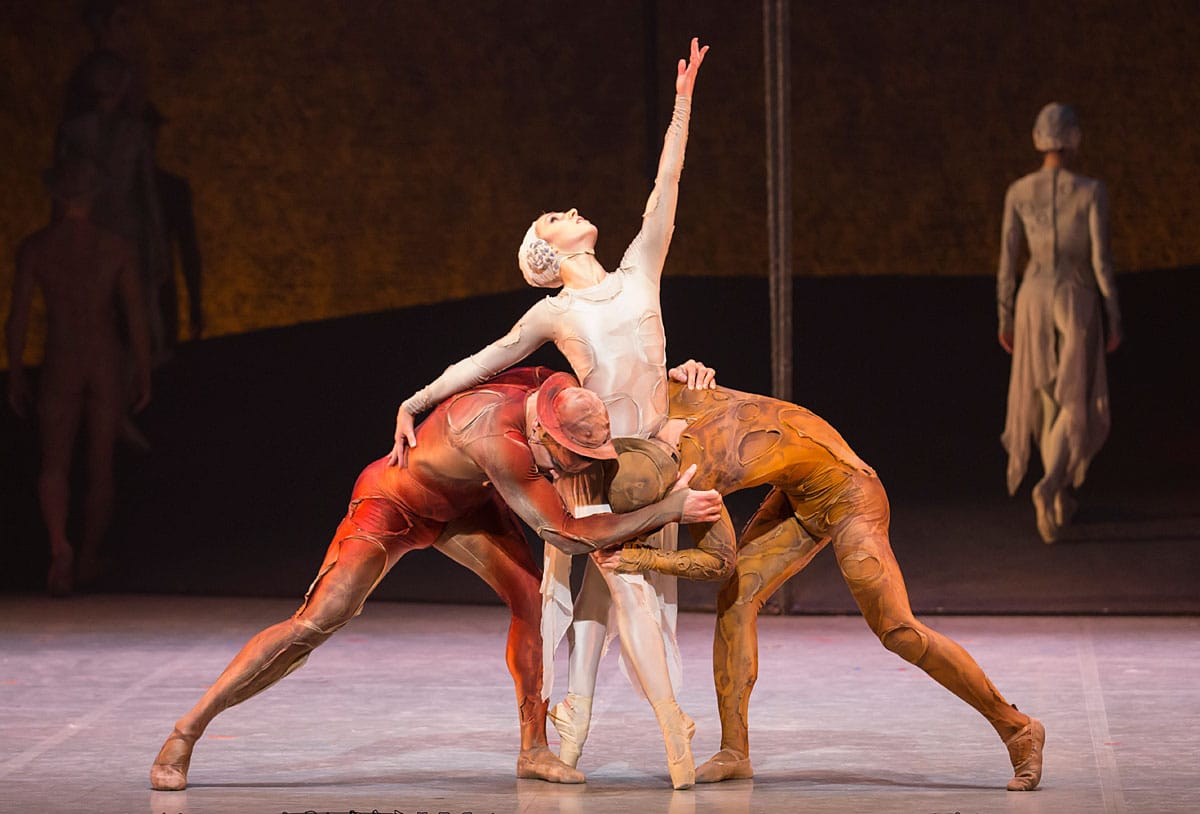
It is possible to see Gloria, Kenneth MacMillan’s howl of rage at the wanton waste of the First World War, as the final piece in a great arc of expressionist dance, from Vaslav Nijinsky’s Le Sacre du Printemps (1913), through Bronislava Nijinska’s Les Noces (1923), to Gloria (1980). The first two works portray a mythicized peasant life, where women are ritually sacrificed for the benefit of the community. The violence they depict, overt in Le Sacre, sublimated into ceremonial in Les Noces, is the violence of their century.
In Gloria, the communal violence is no longer beneficial, or ritualized, but mechanized, the slaughter of millions, so many that the living and the dead can no longer be separated. The vast armies of the dead walk (dance) as one, their numbers stretching away to the horizon. The score, Francis Poulenc’s Gloria, by turns lighthearted, sorrowful and resigned, lays down a palette from which MacMillan paints a vision of both hope and despair: a trio of men find companionship even as they dance with death, before the two main soldiers and their silvery companion – the angel of death? – join the nameless millions as they quietly line up to go over the top. The last soldier looks into the trench, into the pit, before he joins them, not quietly, but leaping, arms outstretched, crucified, the final sacrifice of humanity.
MacMillan achieved the highest aim, knitting the music, sets and costumes (of dusty, brutalized grandeur from Andy Klunder) and lighting (John B. Read) so tightly with his choreography that they form a single unity of vision, as Nijinska did with Natalia Goncharova and Stravinsky in Les Noces. (Nijinsky too may have done so, but the choreography of Le Sacre, despite attempts at restoration, remains unknowable.)
This collaborative vision is what Wayne McGregor too looks for, and for his new work, Tetractys –The Art of Fugue, he has elected to work with Bach (and Michael Berkeley), Tauba Auerbach for sets and costumes, and his regular lighting designer, Lucy Carter. The most enjoyable elements are Auerbach’s neon glyphs, which are raised and lowered over each segment of dance, a beautiful, playfully engaging schematization of the music. But they stand out, and stand alone, barely integrated into a whole.
Each work begins for McGregor with a single, usually theoretical, idea. Each is then mined for half an hour of dance, before being discarded as a new idea provokes the next work. It may be why it is hard to discern any development in McGregor’s work. We’ve had the form of atoms for Atomos, the photographs of Eadweard Muybridge and Richard Serra’s word lists for UNDANCE, virtual reality, PTSD and controlled explosions for Live Fire Exercise, and so on. For Tetractys, it is geometry and numerology, number theory and other games that Bach may, or may not, have been playing with in his mysterious Art of Fugue.
What it isn’t is a serious engagement with the music. The more standard piano and harpsichord arrangements of this work were apparently not considered, or not considered appropriate. Nor, apparently, was the lovely string quartet arrangement (which would also have linked to the four lines of the tetractys). Instead we have Michael Berkeley’s orchestral rendering of two canons and four fugal constructions: perfectly nice, but without much colour.
And in front of this the usual McGregor vocabulary of frantic scurrying, extreme distortion and hyper-extensions plays out, much as it has in all his previous works. A second viewing might have brought a deeper reading, but it was not to be. Dance can be an extreme sport, and in the matinee Natalia Osipova hit her head hard enough (against her partner, apparently) to sustain a concussion. Although she carried on to finish the performance, the evening show had to be cancelled. (That the Royal Ballet cannot field a second cast is astonishing, but in keeping with what appear to be financial constraints elsewhere; the piece’s muddy lighting suggests that onstage technical time was limited.)
The bill opened with Frederick Ashton’s final major work, Rhapsody, choreographed in 1980 for Mikhail Baryshnikov, full of glitter and dazzle, but an odd, unbalanced piece, the male principal’s style set entirely at odds with the rest of the dancers. The Royal has regularly revived the work, although its constant redesign of sets and costumes (originally William Chappell, then Patrick Caulfield, then Jessica Curtis) suggests a level of discomfort with it.
While Valentino Zucchetti debuted admirably, at the moment the Royal does not have a virtuoso of starriest star quality, someone who gobbles up space, who brutally demands attention. Steven McRae, more experienced, led the first cast, and young James Hay, a soloist, performed nicely in a matinee. But at the moment there is a dearth of dazzle in the Royal.
First published in the TLS